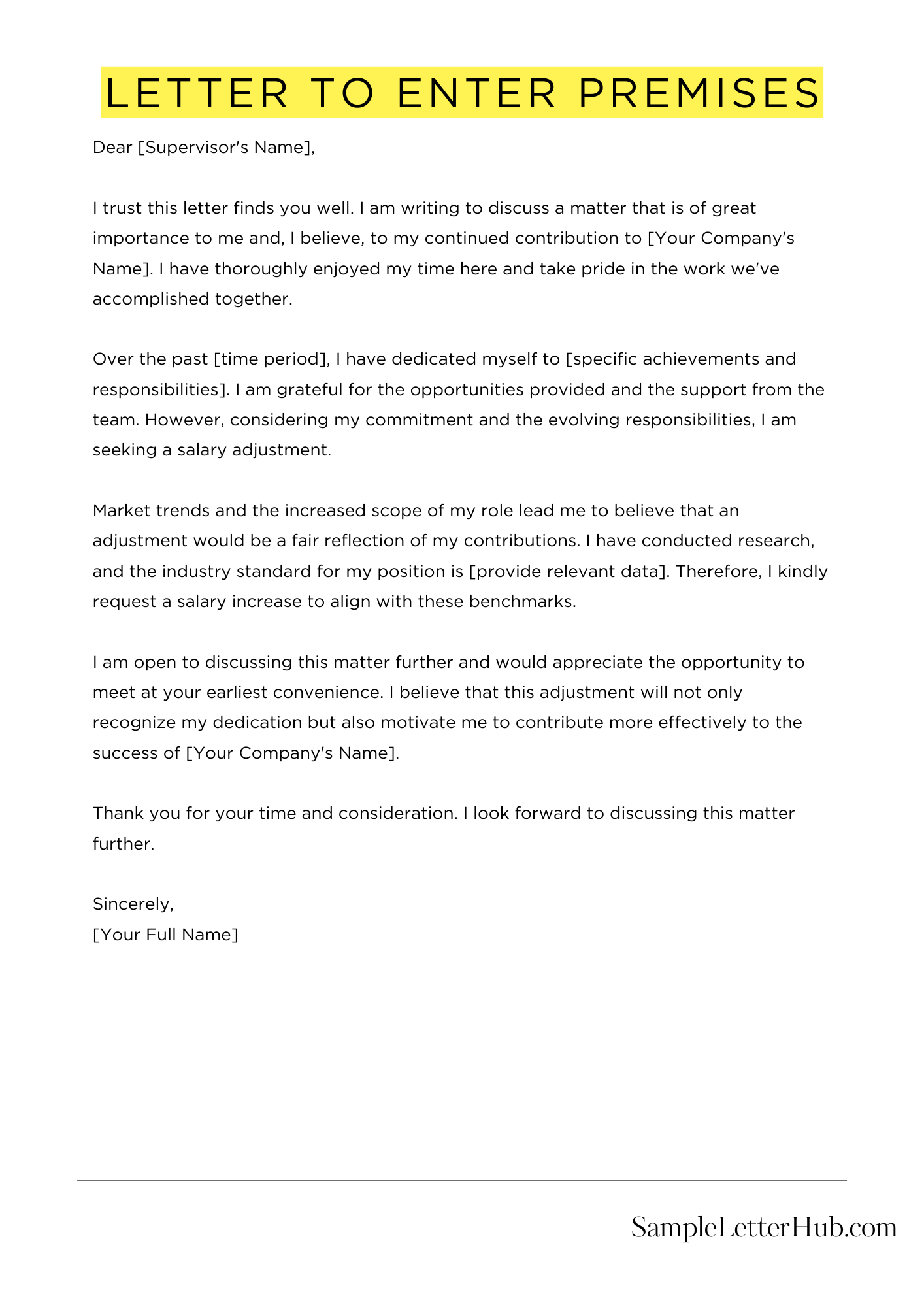A Letter To Enter Premises is a formal request to enter a property that is not yours. It is typically used when you need to access the property for a specific purpose, such as to make repairs or to conduct an inspection.
In this blog article, we will share several templates, examples, and samples of Letter To Enter Premises. These templates and samples will help you to write a clear and concise letter that will get you the access you need.
We will also provide some tips on how to write a Letter To Enter Premises, including what information to include and how to format the letter.
Letter to Enter Premises
Dear Mr./Ms. [Recipient Name],
I am writing to request permission to enter your premises at [address] on [date] at [time].
I am [your name], a representative of [your company]. We are currently conducting a [purpose of visit]. Your premises are of particular interest to us because [reason for visit].
We understand that you may have security concerns, so we would like to assure you that we will take all necessary precautions to minimize any disruption to your operations. We will also respect your privacy and confidentiality.
We would be grateful if you could grant us permission to enter your premises. We believe that our visit will be mutually beneficial.
Please let us know if you have any questions or concerns. We look forward to hearing from you soon.
Thank you for your time and consideration.
Sincerely,
[Your Signature]

How to Write Letter To Enter Premises
Writing a letter to enter premises is a formal request to gain access to a property. It is typically used in situations where the sender does not have the right to enter the property without permission, such as when they are a contractor or inspector.
1. State Your Purpose
The first step is to clearly state your purpose for entering the premises. This could be to inspect the property, perform maintenance, or deliver goods or services.
2. Provide Your Credentials
If you are not the owner or tenant of the property, you will need to provide your credentials. This could include your name, company name, and contact information.
3. Request Permission
Once you have stated your purpose and provided your credentials, you need to formally request permission to enter the premises. This should be done in a polite and respectful manner.
4. Specify the Date and Time
If you have a specific date and time that you would like to enter the premises, be sure to include this information in your letter.
5. Offer Alternatives
If you are unable to enter the premises on the date and time that you have requested, you may want to offer alternative times or dates.
6. Follow Up
Once you have sent your letter, be sure to follow up with the recipient to confirm that they have received it and to answer any questions that they may have.
7. Be Professional
Throughout the entire process, it is important to be professional and respectful. This will help to increase the likelihood that your request will be granted.
FAQs about Letter To Enter Premises
What is a letter to enter premises?
A letter to enter premises is a formal request sent by a landlord or agent to a tenant to request permission to enter the tenant’s property for a specific purpose, such as to conduct repairs or inspections.
When can a landlord enter a tenant’s premises?
A landlord can only enter a tenant’s premises with the tenant’s consent, or in accordance with the terms of the tenancy agreement or applicable law. In general, a landlord can only enter the premises for the following purposes:
- To conduct repairs or maintenance
- To show the property to prospective tenants or buyers
- To inspect the property for safety or compliance with the tenancy agreement
- In an emergency, such as a fire or flood
What should a letter to enter premises include?
A letter to enter premises should include the following information:
- The landlord’s name and contact information
- The tenant’s name and address
- The date and time the landlord wishes to enter the premises
- The purpose of the entry
- A statement that the tenant has the right to refuse entry
What should a tenant do if they receive a letter to enter premises?
If a tenant receives a letter to enter premises, they should carefully review the letter and consider the following:
- Whether they consent to the landlord’s entry
- Whether the landlord has a legal right to enter the premises
- Whether the landlord has given sufficient notice of the entry
What are the consequences of refusing a landlord’s request to enter premises?
If a tenant refuses a landlord’s request to enter premises, the landlord may be able to take legal action to obtain access to the property. In some cases, the landlord may be able to evict the tenant for refusing entry.

